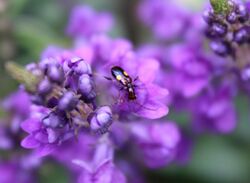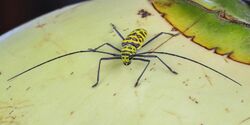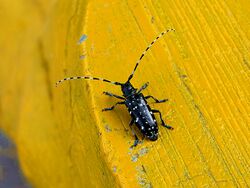Biology:Longhorn beetle
| Cerambycidae | |
|---|---|
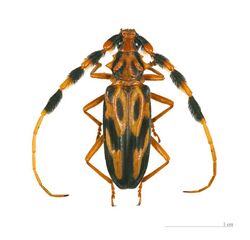
| |
| Batus barbicornis | |
| Scientific classification | |
| Domain: | Eukaryota |
| Kingdom: | Animalia |
| Phylum: | Arthropoda |
| Class: | Insecta |
| Order: | Coleoptera |
| Infraorder: | Cucujiformia |
| Superfamily: | Chrysomeloidea |
| Family: | Cerambycidae Latreille, 1802 [1] |
| Subfamilies | |
|
Eight; see text | |
The longhorn beetles (Cerambycidae), also known as long-horned or longicorns (whose larvae are often referred to as roundheaded borers), are a large family of beetles, with over 35,000 species described.[2]
Most species are characterized by antennae as long as or longer than the beetle's body. Others have shorter pairs (e.g., Neandra brunnea), making them difficult to distinguish from related families such as Chrysomelidae. "Cerambycidae" comes from a Greek mythological figure: after an argument with nymphs, the shepherd Cerambus is transformed into a large beetle with horns.
Though most animals are found in only one biogeographic realm, longhorn beetles are found on all continents except Antarctica.[3]
Description
Other than the typical long antennal length, the most consistently distinctive feature of adults of this family is that the antennal sockets are located on low tubercles on the face; other beetles with long antennae lack these tubercles, and cerambycids with short antennae still possess them. They otherwise vary greatly in size, shape, sculpture, and coloration. A number of species mimic ants, bees, and wasps, though a majority of species are cryptically colored. The titan beetle (Titanus giganteus) from northeastern South America is often considered the largest insect (though not the heaviest, and not the longest including legs), with a maximum known body length of just over 16.7 cm (6.6 in).[4]
Larvae are 0.5–22 cm (0.20–8.66 in) long, elongate in shape and lightly sclerotised. The prothorax is often enlarged and the sides of the body have lateral swellings (ampullae). The head is usually retracted into the prothorax and bears well-sclerotised mouthparts. The legs range from moderately developed to absent. The spiracles are always annular.[5]

Biology
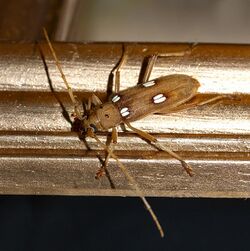
Diet
All known longhorn beetle larvae feed on plant tissue such as stems, trunks, or roots of both herbaceous and woody plants, often in injured or weak trees.[6] A few species are serious pests. The larvae, called roundheaded borers, bore into wood, where they can cause extensive damage to either living trees or untreated lumber (or, occasionally, to wood in buildings; the old-house borer, Hylotrupes bajulus, is a particular problem indoors).
It is known that many longhorns locate and recognize potential hosts by detecting chemical attractants, including monoterpenes (compounds released en masse by woody plants when stressed), ethanol (another compound emitted by damaged plant material), and even bark beetle pheromones. Many scolytinids share the cerambycid's niche of weakened or recently deceased trees; thus, by locating scolytinids, a suitable host can likely be located as well. The arrival of cerambycid larvae is often detrimental to a population of scolytinids, as the cerambycid larvae will typically either outcompete them with their greater size and mobility, or act as direct predators of them (this latter practice is less common, but has been observed in several species, notably Monochamus carolinensis). Cerambycids, in turn, have been found to play a role in attracting other wood-borers to a host.[7] Borgemeister, et al. 1998, recorded that cerambycid activity in girdled twigs released volatiles attractive to some bostrichids, especially Prostephanus truncatus.[8] A few cerambycids, such as Arhopalus sp., are adapted to take advantage of trees recently killed or injured by forest fires by detecting and pursuing smoke volatiles.
Pollination
In addition to feeding on other plant tissue, some species feed on pollen or nectar and may act as pollinators. Assessing the efficacy of beetle pollinators is difficult. Even if pollination of one species by beetles is shown, that same beetle may also act as a flower predator toward other species. In some cases, beetles may act as both pollinators and predators on the same flowers.[9]
Flowers specializing in pollination by beetles typically display a particular set of traits, but pollination by longhorn beetles is not limited to these cantharophilous flowers. A review of angiosperm pollination by beetles shows that Cerambycidae, along with Curculionidae and Scarabaeidae, contains many taxa that are pollinators for not only specialist but also generalist systems.[10]
Beetles in the New Zealand genus Zorion are known to feed on pollen and have a specialized structure similar to that of pollen baskets found in bees.[11] Species in this genus are thought to be important pollinator species for native plants such as harakeke.[12]
Some orchid species have been found to be largely reliant on longhorn beetles for pollination. The species Alosterna tabacicolor was found to be the main pollinator of a rare orchid species (Dactylorhiza fuchsii) in Poland.[13] Another rare orchid Disa forficaria, found in the Cape Floristic Region in South Africa, relies on the species Chorothyse hessei for pollination. D. forficaria uses sexual deception targeting male C. hessei, possibly indicating a long history of co-evolution with longhorn beetle pollinators.[14]
The proportion of longhorn beetle species that act as pollinators is unknown. The fact that two species of longhorn species from distinct subfamilies (Lepturinae and Cerambycinae) found on different continents both with significant roles as pollinators could suggest that some capacity for pollination may be common among longhorn beetles.
Predators
Parasitoids
In North America some native cerambycids are the hosts of Ontsira mellipes (a parasitoid wasp in the family Braconidae).[15] O. mellipes may be useful in controlling a forestry pest in this same family, Anoplophora glabripennis, that is invasive in North America.[15]
Classification

As with many large families, different authorities have tended to recognize many different subfamilies, or sometimes split subfamilies off as separate families entirely (e.g., Disteniidae, Oxypeltidae, and Vesperidae);[16] there is thus some instability and controversy regarding the constituency of the Cerambycidae.[17] There are few truly defining features for the group as a whole, at least as adults, as there are occasional species or species groups which may lack any given feature; the family and its closest relatives, therefore, constitute a taxonomically difficult group, and relationships of the various lineages are still poorly understood.[18] The oldest unambiguous fossils of the family are Cretoprionus and Sinopraecipuus from Yixian Formation of Inner Mongolia and Liaoning, China, dating to the Aptian stage of the Early Cretaceous, approximately 122 million years ago. The former genus was assigned to the subfamily Prioninae in its original description, while the latter could not be placed in any extant subfamily.[19][20] Qitianniu from the mid-Cretaceous Burmese amber of Myanmar, dating to approximately 100 million years ago, also could not be placed in any extant subfamily.[21]
Subfamilies
The eight subfamilies are:[22][23]
- Cerambycinae Latreille, 1802
- Dorcasominae Lacordaire, 1869 (including former Apatophyseinae Lacordaire, 1869)
- Lamiinae Latreille, 1825
- Lepturinae Latreille, 1802
- Necydalinae Latreille, 1825
- Parandrinae Blanchard, 1845
- Prioninae Latreille, 1802
- Spondylidinae Audinet-Serville, 1832 (including former Aseminae Thomson, 1860)
Most species (90.5%) are concentrated in the Cerambycinae and Lamiinae subfamilies.[3]
Notable genera and species
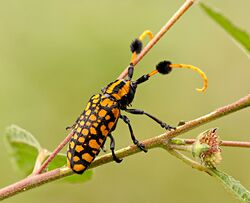
- Acrocinus longimanus – harlequin beetle, a large species where the male has very long front legs
- Anoplophora chinensis – citrus long-horned beetle, a major pest
- Anoplophora glabripennis – Asian long-horned beetle, an invasive pest species
- Aridaeus thoracicus – tiger longicorn (Australia)
- Cacosceles newmannii - Southern African longhorn beetle that is a surgacane pest
- Desmocerus californicus dimorphus – valley elderberry longhorn beetle, a threatened subspecies from California
- Moneilema – cactus longhorn beetles, which are flightless
- Onychocerus albitarsis – the only known beetle with a venomous sting
- Petrognatha gigas – giant African longhorn beetle
- Prionoplus reticularis – huhu beetle, the heaviest beetle in New Zealand
- Rosalia alpina – Rosalia longhorn beetle, a threatened European species
- Tetraopes tetrophthalmus – red milkweed beetle, a toxic species with aposematic colors
- Tetropium fuscum – brown spruce longhorn beetle, an invasive pest species
- Titanus giganteus – titan beetle, one of the largest beetles in the world
- Zorion guttigerum - flower long-horn beetle, an important pollinator species.
See also
- List of longhorn beetle (Cerambycidae) species recorded in Britain
- List of beetles of Nepal (Cerambycidae)
References
- ↑ "Cerambycidae Latreille, 1802". Integrated Taxonomic Information System. https://www.itis.gov/servlet/SingleRpt/SingleRpt?search_topic=TSN&search_value=114497.
- ↑ "The first long-horned beetle giving birth to live young discovered in Borneo". 11 May 2016. https://www.sciencedaily.com/releases/2016/05/160511105403.htm.
- ↑ 3.0 3.1 Rossa, R.; Goczał, J. (2021-01-01). "Global diversity and distribution of longhorn beetles (Coleoptera: Cerambycidae)" (in en). The European Zoological Journal 88 (1): 289–302. doi:10.1080/24750263.2021.1883129. ISSN 2475-0263.
- ↑ Barclay, Max (2010). "Titanus giganteus Linnaeus (1771)". Natural History Museum. http://www.nhm.ac.uk/nature-online/species-of-the-day/biodiversity/loss-of-habitat/titanus-giganteus/index.html.
- ↑ "Wood Boring Beetle Families - Cerambycidae". https://idtools.org/id/wbb/families/Wood_Boring_Beetle_Keys/Woodboring_Families/Media/Html/Fact_sheets/Cerambycidae.html.
- ↑ Kariyanna, B; Mohan, M; Gupta, Rajeev (2017). "Biology, ecology and significance of longhorn beetles (Coleoptera: Cerambycidae)". Journal of Entomology and Zoology Studies 5: 1207–1212. ISSN 2320-7078. https://www.entomoljournal.com/archives/?year=2017&vol=5&issue=4&ArticleId=2190.
- ↑ Allison, Jeremy D.; Borden, John H.; Seybold, Steven J. (2004). "A review of the chemical ecology of the Cerambycidae". Chemoecology 14: 123–150. doi:10.1007/s00049-004-0277-1. https://www.researchgate.net/publication/225670380.
- ↑ Borgemeister, Christian; Goergen, George; Tchabi, Atti; Awande, Symphorien; Markham, Richard H.; Scholz, Dagmar (1998). "Exploitation of a woody host plant and cerambycid-associated volatiles as host-finding clues by the larger grain borer". Annals of the Entomological Society of America 91 (5): 741–747. doi:10.1093/aesa/91.5.741. https://www.researchgate.net/publication/233690356.
- ↑ Gottsberger, Gerhard (1977), Kubitzki, Klaus, ed., "Some Aspects of Beetle Pollination in the Evolution of Flowering Plants" (in en), Flowering Plants: Evolution and Classification of Higher Categories Symposium, Hamburg, September 8–12, 1976, Plant Systematics and Evolution / Entwicklungsgeschichte und Systematik der Pflanzen (Vienna: Springer): pp. 211–226, doi:10.1007/978-3-7091-7076-2_14, ISBN 978-3-7091-7076-2, https://doi.org/10.1007/978-3-7091-7076-2_14, retrieved 2023-10-18
- ↑ Bernhardt, Peter (2000), Dafni, Amots; Hesse, Michael; Pacini, Ettore, eds., "Convergent Evolution and Adaptive Radiation of Beetle-Pollinated Angiosperms" (in en), Pollen and Pollination (Vienna: Springer): pp. 293–320, doi:10.1007/978-3-7091-6306-1_16, ISBN 978-3-7091-6306-1, https://doi.org/10.1007/978-3-7091-6306-1_16, retrieved 2023-10-18
- ↑ Schnitzler, Franz-Rudolf; Wang, Qiao (2005-10-18). "Revision of Zorion Pascoe (Coleoptera: Cerambycidae), an endemic genus of New Zealand". Zootaxa 1066 (1): 1. doi:10.11646/zootaxa.1066.1.1. ISSN 1175-5334. https://biotaxa.org/Zootaxa/article/view/zootaxa.1066.1.1.
- ↑ "Meet our pollinators | EPA". https://www.epa.govt.nz/everyday-environment/animals-and-insects/bees/meet-our-pollinators/.
- ↑ Gutowski, Jerzy M. (1990-01-01). "Pollination of the orchid Dactylorhiza fuchsii by longhorn beetles in primeval forests of Northeastern Poland". Biological Conservation 51 (4): 287–297. doi:10.1016/0006-3207(90)90114-5. ISSN 0006-3207. Bibcode: 1990BCons..51..287G. https://dx.doi.org/10.1016/0006-3207%2890%2990114-5.
- ↑ GASKETT, ANNE C. (2012-04-17). "Floral shape mimicry and variation in sexually deceptive orchids with a shared pollinator". Biological Journal of the Linnean Society 106 (3): 469–481. doi:10.1111/j.1095-8312.2012.01902.x. ISSN 0024-4066. http://dx.doi.org/10.1111/j.1095-8312.2012.01902.x.
- ↑ 15.0 15.1 "PPQ Scientists Evaluate Wasp's Ability to Detect and Attack the Asian Longhorned Beetle". USDA APHIS. http://www.aphis.usda.gov/aphis/ourfocus/planthealth/ppq-program-overview/plant-protection-today/articles/alb-biocontrol.
- ↑ Vanin, Sergio Antonio; Ide, Sergio (2002). "Classificação comentada de Coleoptera" (in pt). Proyecto de Red Iberoamericana de Biogeografía y Entomología Sistemática PrIBES 2002. Monografias Tercer Milenio (M3M). 3. pp. 193–206. ISBN 84-922495-8-7. http://www.sea-entomologia.org/PDF/M3M_PRIBES_2002/193_206_Vanin.pdf.
- ↑ Monné, Miguel A. (2006). "Catalogue of the Cerambycidae (Coleoptera) of the Neotropical Region. Part III. Subfamilies Parandrinae, Prioninae, Anoplodermatinae, Aseminae, Spondylidinae, Lepturinae, Oxypeltinae, and addenda to the Cerambycinae and Lamiinae" (PDF excerpt). Zootaxa 1212: 1–244. doi:10.11646/zootaxa.1212.1.1. ISBN 1-877407-96-8. http://www.mapress.com/zootaxa/2006f/z01212p244f.pdf.
- ↑ Arnett, et al. (2002). American Beetles, Vol. 2. CRC Press, 861 pp.
- ↑ Wang, Bo; Ma, Junye; McKenna, Duane D.; Yan, Evgeny V.; Zhang, Haichun; Jarzembowski, Edmund A. (2013-08-09). "The earliest known longhorn beetle (Cerambycidae: Prioninae) and implications for the early evolution of Chrysomeloidea". Journal of Systematic Palaeontology 12 (5): 565–574. doi:10.1080/14772019.2013.806602. ISSN 1477-2019. http://dx.doi.org/10.1080/14772019.2013.806602.
- ↑ Yu, Yali; Ślipiński, Adam; Reid, Chris; Shih, ChungKun; Pang, Hong; Ren, Dong (January 2015). "A new longhorn beetle (Coleoptera: Cerambycidae) from the Early Cretaceous Jehol Biota of Western Liaoning in China" (in en). Cretaceous Research 52: 453–460. doi:10.1016/j.cretres.2014.02.019. Bibcode: 2015CrRes..52..453Y. https://linkinghub.elsevier.com/retrieve/pii/S0195667114000378.
- ↑ Lin, Mei-Ying; Bai, Ming (July 2017). "Qitianniu zhihaoi gen. et sp. nov.: The first cerambycid beetle found in Cretaceous Burmese amber (Coleoptera: Chrysomeloidea)" (in en). Cretaceous Research 75: 173–178. doi:10.1016/j.cretres.2017.03.030. Bibcode: 2017CrRes..75..173L. https://linkinghub.elsevier.com/retrieve/pii/S0195667116304050.
- ↑ Bouchard, Patrice; Bousquet, Yves; Davies, Anthony E.; Alonso-Zarazaga, Miguel A.; Lawrence, John F.; Lyal, Chris H. C.; Newton, Alfred F.; Reid, Chris A. M. et al. (2010). "Family-group names in Coleoptera (Insecta)". ZooKeys (88): 1–972. doi:10.3897/zookeys.88.807. PMID 21594053. PMC 3088472. https://www.pensoft.net/journals/zookeys/article/807/family-group-names-in-coleoptera-insecta-Cerambycidae.
- ↑ Švácha, P.; Lawrence, J. (2014). "2.4. Cerambycidae Latreille, 1802". in Leschen, R.A.B.; Beutel, R.G.. Handbook of Zoology, Arthropoda: Insecta; Coleoptera, Beetles, Volume 3: Morphology and Systematics (Phytophaga). Berlin/Boston: Walter de Gruyter. pp. 77–177. doi:10.1515/9783110274462.77. ISBN 978-3-11-027446-2. https://www.zin.ru/animalia/coleoptera/pdf/svacha_lawrence_2014_cerambycidae.pdf.
Further reading
- Monné, Miguel A. & Hovore, Frank T. (2005) Electronic Checklist of the Cerambycidae of the Western Hemisphere. PDF Cerambycids.com
External links
- Photo gallery "Longhorn beetles (Cerambycidae) of the West Palaearctic Region"
- [1] and [2] Catalogs of New World and Old World Cerambycidae, respectively
- Cerambycidae of French Guiana
- National Museu, Rio, Brazil Holotype images
- Iberodorcadion Coleoptera, Cerambycidae, Dorcadion - RedIRIS
- VIDEOS - Longicornes (Dorcadion, Cerambycidae, Coleoptera)
- Cerambycidae of Borneo pdf
- BugGuide.net - Longhorned Beetles (Cerambycidae)
- Anoplophora chinensis, citrus longhorned beetle on the University of Florida / Institute of Food and Agricultural Sciences Featured Creatures website
- Coleoptera: Cerambycidae, University of Florida, Dept. of Entomology and Nematology
- Wood-boring beetles of the World
- [3]
Wikidata ☰ Q205295 entry
 |
